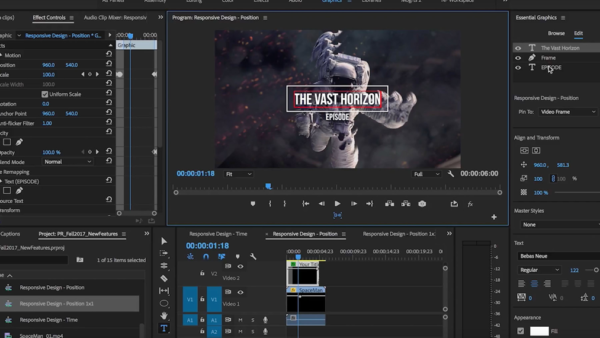News
Adobe announces new features in its Suite
 Like so many other companies, the software company, Adobe Systems Incorporated, has also taken advantage of the IBC show, which we have been talking about for several days to make public some news in advance, which will be included, soon, in its Adobe Creative Cloud system.
Like so many other companies, the software company, Adobe Systems Incorporated, has also taken advantage of the IBC show, which we have been talking about for several days to make public some news in advance, which will be included, soon, in its Adobe Creative Cloud system.
Tools designed to help filmmakers and industry professionals create content. On this occasion, Adobe focused on new features related to teamwork, new VR support for Premiere Pro, and Character Animator v1.0.
In the words of Bryan Lamkin. “Video is about the fastest growing media in communication and entertainment. Whether you’re a creator, a company or a filmmaker, you need to move that content across all platforms and formats at incredible speed (…) Adobe is entering a new field of collaboration, sharing that aims to accelerate workflows for creators.”
As you can guess from the words of Adobe’s senior vice president of Digital Media, one of the features that the company has advanced is precisely the possibility that will give users the ability to work on the same project at the same time. A novelty included in Premiere and in which Final Cut had been ahead for several years.
It will also allow, precisely to facilitate this collaborative work, to put locks on the project, in order to prevent them from modifying something that someone else is working on.
Premiere Pro
There have been modifications to Premiere’s Essential Graphics panel, as well as the Lumetri color panels. The program will now support both WAV files larger than 4GB and Sony X-ONC .
However, what Adobe has emphasized the most about what’s new in Premiere is the integration of VR between Premiere Pro and After Effects. This will make it possible to transform sequences into 360º content.
About Adobe Audition CC
Although its speed has been increased making it faster, the major feature included in this program is the inclusion of auto-ducking to insert music tracks under dialog tracks.
The beta version of Character Animator CC has been removed.
In this version, a new control panel has been included that surpasses what until now was controlled with keyboard shortcuts. The movements that animate both the eye and the eyebrows have also been improved, with the aim of making it look more natural, as well as the doll’s own expressions and movements.
But the biggest novelty is the integration of the Adobe Sensei algorithm, thanks to which the doll’s mouth moves in correspondence with the sound that the doll makes. And now it is no longer necessary to capture live audio to animate the doll, or import sound clips in AIFF format, but this system has been integrated with Adobe Audition and can be imported directly from there.
Adobe has not said an exact date as to when these new features will be available, but has stated that it will be in the fall of 2017.

